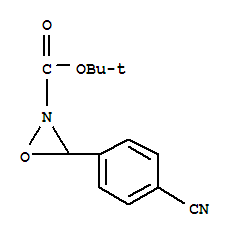C13H14N2O3

密闭于-20°C阴凉干燥环境中
遵照规定使用和储存则不会分解。
1. 性状:白色结晶性粉末
2. 密度(g/mL,25/4℃):无可用
3. 相对蒸汽密度(g/mL,空气=1):无可用
4. 熔点(ºC):57-63
5. 沸点(ºC,常压):无可用
6. 沸点(ºC,5.2kPa):无可用
7. 折射率:无可用
8. 闪点(ºC):无可用
9. 比旋光度(º):无可用
10. 自燃点或引燃温度(ºC):无可用
11. 蒸气压(kPa,25ºC):无可用
12. 饱和蒸气压(kPa,60ºC):无可用
13. 燃烧热(KJ/mol):无可用
14. 临界温度(ºC):无可用
15. 临界压力(KPa):无可用
16. 油水(辛醇/水)分配系数的对数值:无可用
17. 爆炸上限(%,V/V):无可用
18. 爆炸下限(%,V/V):无可用
19. 溶解性:无可用
该物质对环境可能有危害,对水体应给予特别注意。
| Name: | N-BOC-3-(4-Cyanophenyl)oxaziridine Material Safety Data Sheet |
| Synonym: | N-Boc-3-(4-cyanophenyl)oxaziridine |
| CAS: | 150884-56-3 |
| CAS# | Chemical Name | content | EINECS# |
| 150884-56-3 | N-BOC-3-(4-Cyanophenyl)oxaziridine | 100 | unlisted |
1、 摩尔折射率:64.52
2、 摩尔体积(m3/mol):196.6
3、 等张比容(90.2K):528.5
4、 表面张力(dyne/cm):52.1
5、 极化率(10-24cm3):25.57
1.疏水参数计算参考值(XlogP):2.3
2.氢键供体数量:0
3.氢键受体数量:4
4.可旋转化学键数量:3
5.互变异构体数量:无
6.拓扑分子极性表面积65.6
7.重原子数量:18
8.表面电荷:0
9.复杂度:371
10.同位素原子数量:0
11.确定原子立构中心数量:0
12.不确定原子立构中心数量:1
13.确定化学键立构中心数量:0
14.不确定化学键立构中心数量:0
15.共价键单元数量:1